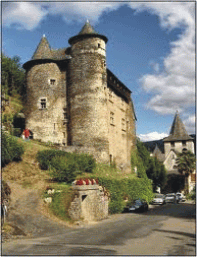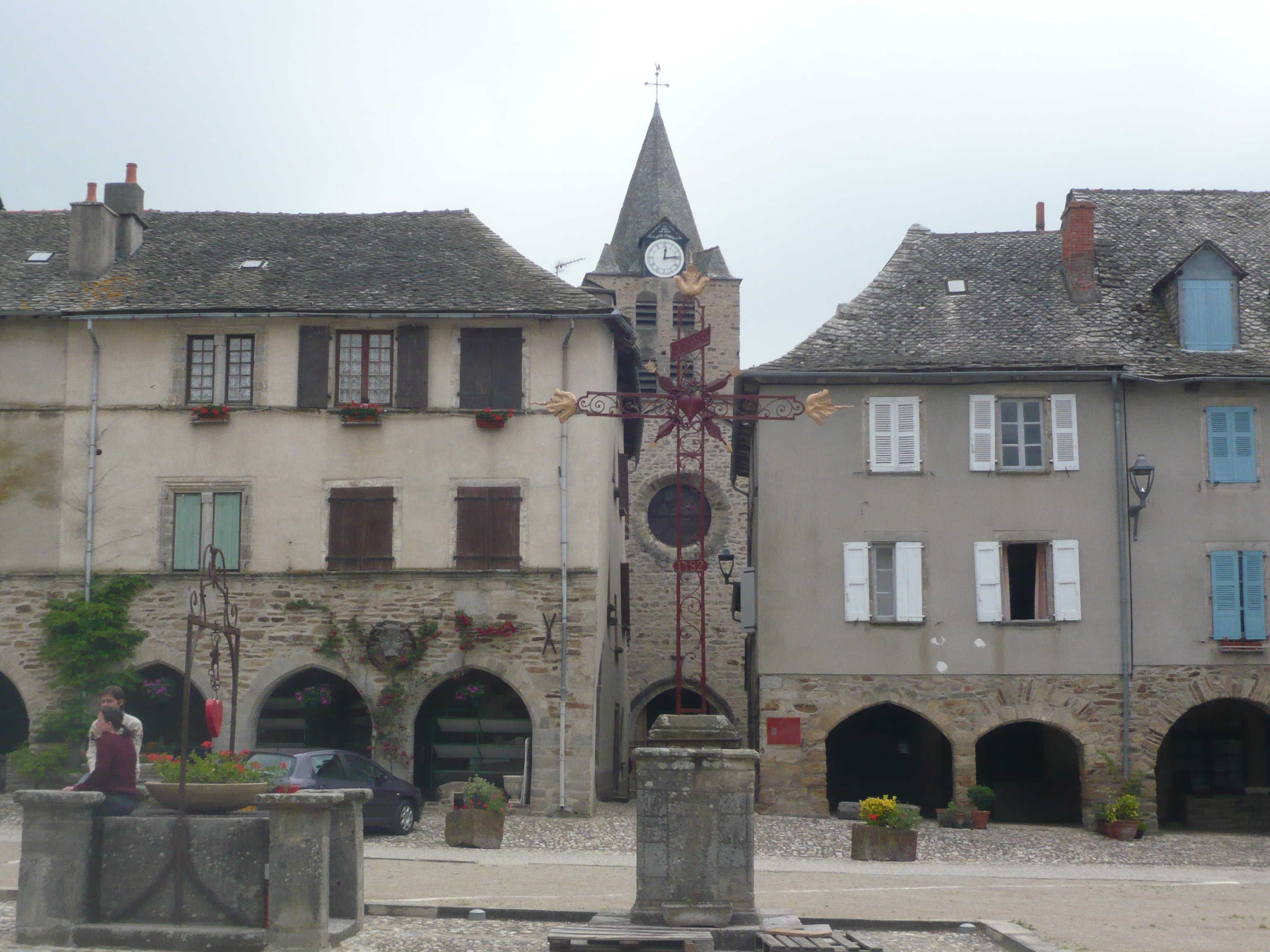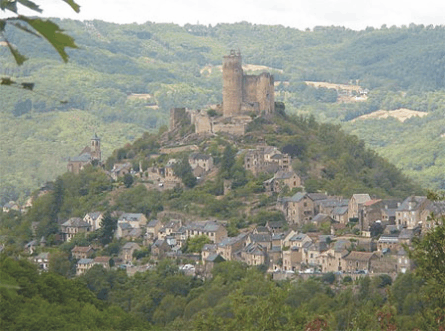 The
Ranums'
The
Ranums'
Panat Times
Volume 1, redone Dec. 2014
Michael Wolfe on Walled Towns
Michael Wolfe, Walled Towns and the Shaping of France (New York: Palgrave, 2009), pp. 266.
Not urbi but oppida, Roman walled towns surrounded by walls and gates all across Roman Gaul, way up in the North and the West, not just in the South. Probably already decaying in many places, the stone structures would last much longer than the wooden ones; but it would seem that at least 500 years would transpire before any serious restoration or extension of the old stone walls would be undertaken. In the countryside, castellans (low-ranking nobles) would build defensive structures for their own families, and by the eleventh century some of these structures would be quite impressive — usually having square towers and some curtain walls and gates to protect the villagers who built houses below or adjacent to the fortified place. Great feudal families and kings, English and French, slowly gained control over congeries of rights and domains that would evolve into provinces, often along the borders of the long defunct Roman administrative units that survived as dioceses.
These great feudal families built towers next to the walled towns that they “protected.” Actually, the humble castellan offered protection and collected fees and rights in structurally about the same way as did great feudal families such as the Capetians, the Plantagenets, and the Toulouses, who extended over much greater expanses of land. Protection and payment of fees constituted the fundamental elements of state-building.

To give examples that support Wolfe’s analysis, let’s have some from the environs of Panat. Castellans could collect tolls on the Lot River, for example at Vieillevie (above); the kings of France did the same thing on the Seine! The great feudal “protectors” did not automatically subsidize the townsmen in their wall-building projects. Their sense of the geography of power remained more strategic, with the result that in the first great age of castle-building, the “passages to ...,” the places where rivers flowed into each other, and eventually the bridges over them, remained the priority.
Only in the later thirteenth century did the great feudatories begin to charter small towns (they were known as bastides), in part to extend their powers of protection, but also to increase their revenues. In bastides, housing lined squared streets; there were market squares, walls, and gates. They grew at very different rates over the following centuries. Again from the Aveyron is Villefranche-de-Rouergue, due west of Rodez (viewed from the air).
Its charter served as a model for other bastide towns. Its characteristic grid is still very much present, as is the huge tower of its collégial and the charterhouse on the outskirts of town. A tourist might think that Villefranche was a cathedral town; but it was a town for royal justice, and its prosperity particularly resulted from refining and “exporting” copper. Sauveterre-de-Rouergue, a bastide town on much higher country south of Rodez with a fair, hat-makers and wine producers, had far less commercial power than Villefranche. Quite frozen in time, little Sauveterre now attracts more tourists than Villefranche.

The capitals of the great feudatories invariably had bishops or
archbishops, and before they became ducal or royal seats, they possessed
already established administrative personnel, law courts, and not
infrequently mints. The question of who would pay for the upkeep and
construction of walls, donjons, and gates would perennially agitate
merchant communities. Counts and dukes could appear generous by
assigning some of their revenues to help the townsmen defray costs; but
in the end it would be the locals who paid! Of strategic importance in
the wars with the Plantagenets, so “wild” a place as Peyrusse-le-Roc
(with its two towers on a rocky outcrop) would have required outside
royal subsidies to build the towers. This probably was also the case for
Najac, another bastide town, but one with a very costly castle
and chapel built by Alphonse de Poitiers. The design and the
engineering, as well as the beauty of the stonework, must have
intimidated the local nobles in their rough stone castles.


Walled towns welcomed and grew, as walls and cathedrals changed the horizons along rivers and on the plains of the Beauce.
The heightened sense of insecurity of the Hundred Years’ War made administrative relations between the town fathers and the royal officials more coherent and less haphazard. Royal authorization might be required for building new walls, as in Rouen in the 1340s; but it was the local government that made the decisions about where to build and how to pay for the new defenses. A vague but important sense of “public good” associated with protection, made it easier for the city father to borrow money. We do not learn whether master masons and their laborers benefitted from these construction projects, or whether itinerant artisans were hired.
While there were certainly exceptions, the Hundred Years’ War
fostered a climate of localist and urban self-defense. City fathers had
to tax and borrow in order to pay for ever-higher and ever-stronger
walls and gates. The power to raise money could be considered power tout
court. Tensions between bishops and city fathers probably increased as
the clerical seigneurs collected revenues but were reluctant to pay
their “fair share” for the defenses from which they benefitted.
After
about 1430, the French kings began to claim realm-wide responsibilities
for defense, while forbidding both towns and great nobles to negotiate
with any and all “foreign powers” — notably the English. The citadel
would not be the same as the keep. If not always stronger, the citadel
in many cases could actually be lived in; and while its aim for the
Crown was protection against the king’s enemies, it could also begin to
intimidate any town governments who refused to cooperate on “revenue
sharing.” Louis XI sought to keep the realm on the ready for war
footing, with realm-wide taxes, a standing army, and companies of
gens d’armes in the citadels and fortifications of the bonnes
villes. Tocqueville would begin his essay on the Ancien Régime with
the reign of Louis XI, partly because of the new permanent militarism
and its fiscal consequences.
The Italian wars would bring French governing elites to adopt new designs for town fortifications and to set in motion the education and training of architects and engineers. These architects and these engineers would still learn from the established skilled artisans and master builders who, from their oral cultures and their hands-on experience, already knew how to build castles and walls; but they would also challenge them. Mathematics would (like Latin for physicians) be the qualifying knowledge for both artisans and architects, with the former making perhaps as many innovations as the latter — for example, the stone self-supporting trompe (cantilevered trumpet squinch) for which a mason, Desargues, would establish the geometry.
An aesthetic dimension sometimes lay beneath the pride over wall-building of the urban elite, or of a bishop. Witness, at Rodez, Cardinal d’Armagnac’s sponsorship of Philandrier’s Vitruvius-inspired and quite decorative wall, with its Latin inscriptions.
The Hapsburg-Valois Wars would result in pouring enormous amounts of resources into fortifications around towns and on the frontiers, and into the building nearly stationary cannon emplacements and supplying them with weapons, shot, and powder. Even so, towns in the interior kept large quantities of traditional arms, and some more advanced, often Italianate weapons — all of which would be used in the military clashes unleashed by religious division.
With a particular focus on the walled towns, Wolfe offers a masterful synthesis of the whole military dimension of the Wars of Religion. His first point is that while towns were jealous of their liberties, these liberties were, after all, granted by kings; and the town defenses were not originally conceived as offering protection from a royal army. The increasing strength of the Protestant military, as early as 1562, seems to emerge from nowhere; but of course, many had been trained with the Spanish in mind. Wolfe’s second point is that, faced with religious division, the urban elites (already weakening) divided largely between those who already held royal office or were seeking it, and those for whom the municipal office constituted their full political identity. As Kevin Robbins found, after the disastrous siege of La Rochelle, the town fell entirely under the sway of royal judicial officials — the end of a trajectory begun decades earlier.
Typically, towns did not become monolithically Catholic or Huguenot, 1560-1590; but as the military campaigns shifted the political dominance of one or the other religion, the rush to build new fortifications came to be measured almost in proportion to the threats that came and went. One can propose a dynamic that might be confirmed by the study of numerous towns, namely: the ordering of new defenses by a town government might consolidate its power, be it Catholic or be it Huguenot, until it was disgraced by a siege and capture; while commissioned works might actually serve to consolidate the powers of the conquerors. There is probably no way of finding out precisely what the lead time was in building town fortifications during the sixteenth century; thus it is impossible to determine just how important building new fortifications was to the outcome of the wars! The other variables — for example, population size, size of attacking armies, supplies available to the besieged town-dwellers, and of course religious-political divisions — make it impossible to elucidate just how important new fortifications were to the survival of the Huguenot movement.
Wolfe pays particular attention, and rightly so, to the fates of three Huguenot towns: Montauban, Sancerre, and La Rochelle. New defenses were built to intimidate besiegers and to defeat them if attacked. Their fate became — along with Montpellier’s – the fate of the realm-wide Huguenot movement, as greater awareness through broadsheets and pamphlets developed across the realm. Catholics cheered and held masses when a city was defeated; Huguenots grew pessimistic and speculative about the duc de Rohan’s true aims and his competence as a general, and about why God was abandoning them. Wolfe rightly emphasizes the construction of fortifications, but the orders to tear down what had just been built humiliated city elites and altered the very identity of towns. Poor Millau had not only gone deeply into debt, like so many other Huguenot towns, it had also loaned money to Rohan and would never recover it. In addition, it had plans for an entirely new defense system that bristled with bastions that would never be built (Jacques Frayssenge, Millau, p. 41).
Would a Chinese visitor have been able to distinguish a Huguenot walled town from a walled town under the control of the Catholic League? Neither party had a monopoly on new fortification techniques, nor was one party better able than the other to mobilize resources. Thus the crucial factors were the brutal cutting down of the Huguenot leadership in 1572, not just in Paris but all across the realm, and the slow “winning of the initiative” by Henry of Navarre, as much (if not more) on the field of battle as in taking walled towns.
Amiens had proudly declined royal military support before falling to the Spanish in 1597, in a sneaky manner that would presage the way Henry “captured Paris.” The fate of Amiens undermined whatever general current had existed toward enhanced power for urban elites (Finley-Croswhite). The first Bourbon king was certainly not the first monarch to turn consular elections into a farce; but in former League towns, as in Huguenot towns, the inexorable triumph of black-robed judicial officials — greffiers, trésoriers de France, présidiaux, and royal controlleurs of this and that, usually from well-to-do local families — came to power and replaced their merchant-elite relatives.
Wolfe’s analytical narrative of the siege of La Rochelle, 1628, brings out for me, as never before, just how the blockade of the port was not just the execution of one design, it resulted from a series of failures and adaptations that involved massive works that had the sea as the principal enemy. Over the years, Richelieu pushed almost in fury, where others would have given up and fought another day. The mathematicians and engineers were not along just for the ride; but it is not evident that they were making the crucial difference between victory and defeat. As they headed for Savoy, the king and the cardinal sized one another up within that supreme political frame, military power; and the cardinal discovered the warrior king whose health was better when campaigning than it was at court.
The administrative-fiscal state that really appeared in the last campaigns against the Huguenots (Alexandra Lublinskaya) would de-fortify towns in the interior, and would turn the entire realm into a massive frontier fort. In between this massive shift that went on for more than a century, frontier citadels not only remained, there would also be a strong trend to construct citadels in some interior towns. The cannons of the Bastille had been trained on the capital until the Grande Mademoiselle ordered them turned and aimed at the royal army in order to save Condé. In Bordeaux, the Ormée tore down, in celebration, the Château du Hâ, a harbinger of events in Paris in July 1789. Mazarin would decide that it was necessary to rebuilt Hâ; but fear of a Spanish or English attack was not the priority. For decades to come, gens d’armes — they wore pretty uniforms and attended local balls — would be lodged in these sometimes not very comfortable living quarters. City militias declined, as the gates they guarded became arches of triumph. The low walls, tunnels, and bastions built under Napoleon III, north of Paris and at Strasbourg, etc, would never strengthen the urban identities they were designed to protect. The building of the Maginot line was the culmination of the Vauban master plan in the North East for turning the realm into a fortress. Tanks and air power, hélas.
Wolfe has accomplished much in this very well researched and
well-constructed book that illuminates a major feature of French urban,
social, scientific, and political history. The current French obsessions
with biography and local history will probably mean that Wolfe’s book
will not be translated and published with a hundred illustrations. But
it certainly should be!